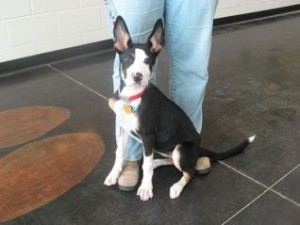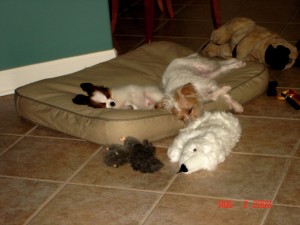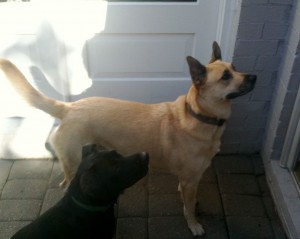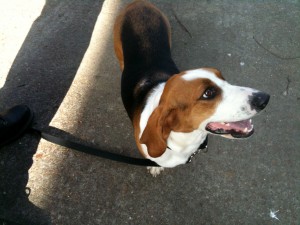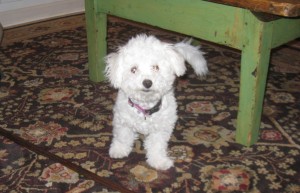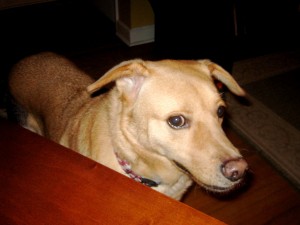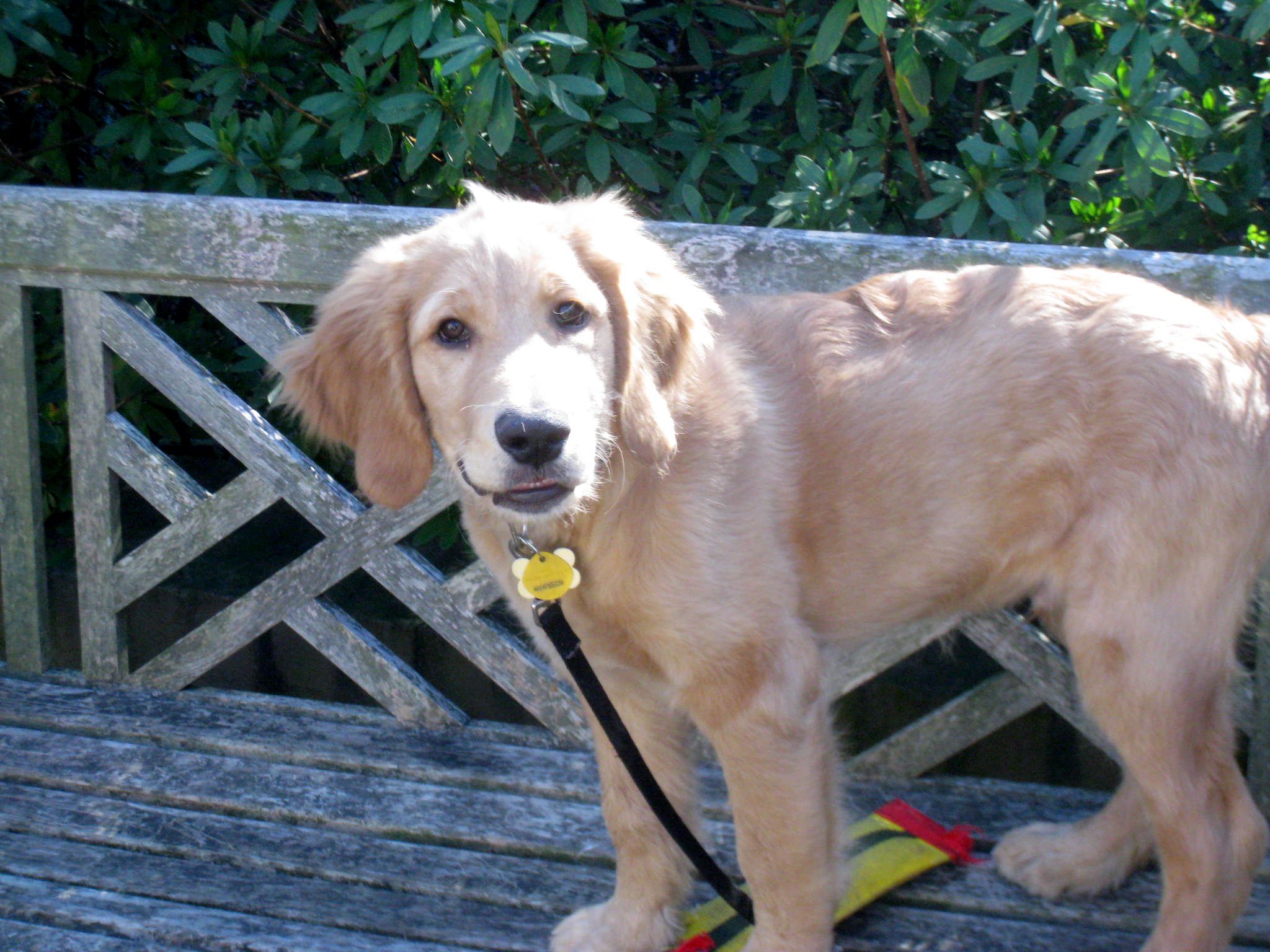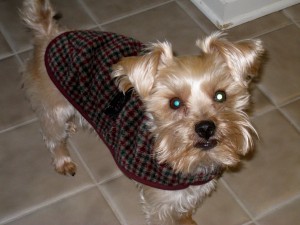 Most people state they want their dogs to bark to signal the nedd to go outside to potty. I suggest teaching the dog to ring a bell instead of teaching the dog to bark. The dog will inevitably signal when she doesn’t need to use the bathroom but she does want you to interact. If you teach her to bark at you, she will learn to bark at you for attention.
Most people state they want their dogs to bark to signal the nedd to go outside to potty. I suggest teaching the dog to ring a bell instead of teaching the dog to bark. The dog will inevitably signal when she doesn’t need to use the bathroom but she does want you to interact. If you teach her to bark at you, she will learn to bark at you for attention.
If you teach her to ring a bell, you can always take the bell off the doorknob. In addition, you can take the bell to a hotel room, a friend’s house, the basement, or anywhere you want.
I suggest placing a bell on a string and hanging the string on the doorknob, but you can always hang the bell on your easy chair, kitchen island, bed post, or anywhere you like. Hobby and craft supply stores carry the ball-like bells in several sizes. String two or three on a leather string for a full sound!
Some people use a wireless doorbell and teach the dog to push the button with her paw or nose. This allows them to place the ringer near to them, when the door and the dog may be rooms away. This requires a bit more training to teach the dog to bump the button hard enough to ring the wireless bell.
Method two is best if you want to use a wireless doorbell.
It doesn’t matter where you place the bell or if you use a wireless doorbell. The concepts for teaching are the same. Just adapt these instructions for your situation. There are several ways to teach your dog to bump a bell to signal a desire to go out. I’ll list two of them here.
Method One is simple to follow but may take some dogs longer to learn.
Method Two takes more time and thought and effort, but works with all dogs and is best if you want to use a wireless doorbell. You decide which Method is best for you!
Method One
Hang a bell on the door that Caroline exits to go potty. Leave the bell on the door from this point forward. Before you ever touch the doorknob, reach down and bump the bell with your hand.
Always bump the bell with your hand, and then open the door. Do this for several days.
If she sniffs or noses the bell, make a fuss as you praise her and then open the door. If you want, you can speed up the process by placing a teeny tiny bit of peanut butter on the bell. When she sniffs or licks it, praise her, open the door and walk her to the elimination area. Give the command to potty. After she eliminates, give her a treat, play with her, toss a ball, take a walk, et cetera.
Once she learns that interacting with the
bell makes you open the door, you can teach her to bump it with her nose. Just ignore her when she sniffs or licks and she will “sniff harder”. Wait until she bumps the bell just a bit harder.
There are many variations for Method One.
Some people gently take the dog’s paw and strike the bell before they go out.
If your dog knows how to shake, you can cup the bell in your hand to get your dog accustomed to pawing the bell. Experiment with variations and see which works best for your pup!
Method Two
This is the method you can use to teach your dog to bump a doorbell button or a bell hanging from the door. Just adapt the instructions to your situation.
Some dogs and some trainers might skip a step or perform additional steps. Use this outline as a guide to develop your own program.
After step 1, perform each step in very short sessions over the next few days.
Do not move on to the next step until you are sure that Caroline knows the current step.
If Caroline seems confused, go back to the last step that she understands and work from that point forward.
Teach Caroline:
1. a signal that will communicate success and motivate her
2. to bump the bell
3. to bump the bell when it is
hanging on the door
4. to bump the bell and then step
outside
5. to bump the bell, step outside
and walk to the elimination area
6. to bump the bell, step outside,
walk to the elimination area and
eliminate
Before you can teach any animal, you must be able to communicate what you want and you must be able to motivate the animal to want the same thing.
At the very least, you should be able to tell the animal the instant he or she has succeeded. Some people use a clicker to communicate the instant of success, but you don’t need a clicker to communicate.
You can pair any unique word or sound with treats and create your own unique signal. It is best if the word is not a common word; it should stand out as a unique signal. Initially, you’ll pair the signal or marker with food treats so the dog will be motivated to perform behaviors that cause you to deliver the signal. I use the word “kick” for the signal.
Step 1
Teach Caroline a signal that will communicate success and motivate her.
Say “kick”, and say it quick, like a sound instead of the actual word. Immediately toss Caroline a soft and tasty, bite-sized treat. Repeat ‘kick and treat’, 3-8 times. By now the sound should be conditioned and you should have her attention.
To test the signal, wait until Caroline is not looking at you but is close by. Say “kick” one time. She should turn her head towards you really fast. If not, just stop the exercise and start from the beginning at another time.
Say nothing else during this exercise.
The “kick sound” must precede the treat, so be sure and wait a second before you toss the treat. Once you have conditioned “kick”, you have a great tool to tell Caroline the instant she creates wanted behaviors.
You’ll mark the instant of success with the word “kick” and follow the ‘kick’ with good stuff, like a treat, toss of a ball, verbal praise or a quick pat.
Once kick is conditioned, you don’t need to repeat this step and you don’t need to deliver the treat immediately after the kick (marker). You can deliver the treat or good stuff several seconds after the marker.
Step 2
Teach Caroline to touch a bell hanging on a string in your hand.
Hold the string so the bell is at Caroline’s nose height, an inch away from her nose. Say nothing. Wait until Caroline sniffs the bell with her nose.
The instant her nose touches the bell, say kick and then immediately deliver a food
treat.
Perform this step several times, but hold the bell just a bit farther and farther away from her nose each time. Say kick the instant she touches it and then give her a food treat. Practice 5-8 times and then place the bell in a drawer or out of sight.
Hold a few sessions just like the first one until Caroline becomes excited when she sees you get the bell out of the drawer. Go to step 3 after Caroline will readily bump the bell whenever she has the opportunity.
Step 3
Teach Caroline to touch the bell when it’s hanging on the doorknob.
Hang the string on the doorknob so that the bell is at Caroline’s nose height. Sit or stand next to the bell. When she touches the bell on a string attached to your doorknob, say kick and then immediately deliver a tasty treat. Repeat 5-8 times per session. After each session, place the bell in a drawer or out of sight.
Step 4
Teach Caroline that the treat after the “kick” is delivered right outside the door.
When she touches the bell on a string attached to your doorknob, say kick, open the door; walk outside and then deliver the treat right outside the door. Repeat 5-8 times per session.
After each session, place the bell in a drawer or out of sight.
Step 5
Teach Caroline that the treat after the “kick” is delivered after she walks to the elimination area.
Same as step 4 but walk to the elimination area (she will probably follow you) and deliver the treat there. Repeat 5-8 times per session. After each session, place the bell in a drawer or out of sight.
Step 6
Teach Caroline that the treat after the “kick” is delivered outside at the elimination area after she eliminates.
Introduce this step when you know she needs to eliminate, such as her first outing in the morning.
Same as Step 6 but once you arrive at the elimination area, give her your command for potty and then give her a treat after she eliminates. Practice this step the next few mornings – and any other times throughout the day that you know Caroline needs to eliminate.
After a few days of practicing step 6, you can drop the word “kick” and the food treat from the sequence. Instead of a food treat, praise her, play fetch, or take her on a walk. Now, you can leave the bell on the doorknob.
When she rings the bell, say something like, “Ok, you need to potty?” and walk her outside to the elimination area. Give her the cue to eliminate.
After she eliminates, deliver something good. Toss a ball or take her for a walk in the neighborhood.
At his point, it’s important to always open the door and go out to the elimination area every time she bumps the bell. If she eliminates, then give her a treat. If she doesn’t eliminate after you’ve given the command, just go back inside. You can leave her out of not, depending on how you feel about your dog being in the yard alone.
After a few days, you can stop walking
all the way to the elimination area and
stop giving her the command to eliminate.
Just open the door and walk halfway to the area. If she eliminates, perfect, give her a reward!
Over the next few days, reduce the amount of steps you take towards the elimination area.
In about a week, you should be able to wait at the door while Caroline goes out to eliminate.
It’s okay to give her a treat after she returns, for now she knows the treat is for eliminating, not for returning.
Some dogs learn to ring the bell to get you to interact, but they don’t need to eliminate. Keep a log of feeding and elimination. This will help you recognize the times she needs to go outside. If Caroline bumps the bell when she does not have to eliminate, she is telling you that she wants more mental and physical stimulation. Consider taking her for a walk or holding a short training session to stimulate her!
 Print This Post
Print This Post
Happy Training!
Alan J Turner
Companion Animal Behavior Counselor – Canine Specialization
How’s Bentley Memphis TN
Private and Group Puppy Obedience Courses
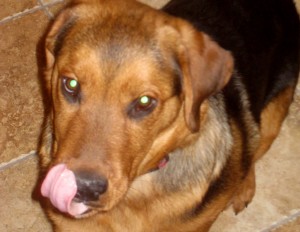 One of the neat things about using an instant reward marker is how you can capture a natural behavior and then teach your dog to do it on cue.
One of the neat things about using an instant reward marker is how you can capture a natural behavior and then teach your dog to do it on cue.
